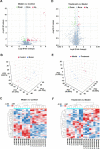Influence of warm acupuncture on gut microbiota and metabolites in rats with insomnia induced by PCPA
- PMID: 35482778
- PMCID: PMC9049555
- DOI: 10.1371/journal.pone.0267843
Influence of warm acupuncture on gut microbiota and metabolites in rats with insomnia induced by PCPA
Abstract
Background: Insomnia is the most common of the sleep disorders. Current pharmacotherapy treatment options are usually associated with adverse effects and withdrawal phenomena. Therapeutic alternatives with a more favorable safety profile for patients are needed. Mongolian medical warm acupuncture (MMWA) is an emerging therapeutic option for treating insomnia. However, the underlying mechanisms responsible for the anti-insomnia efficacy of the MMWA remain unclear. This study aims to investigate the effect of the MMWA on the alterations of the gut microbiota and serum metabolome in rats with insomnia.
Results: We found that the relative abundances of gut bacteria and the concentrations of several serum metabolites were obviously altered in PCPA-induced insomnia rats. The MMWA treatment exerted an anti-insomnia effect. In addition, the dysbiosis of the gut microbiota and the serum metabolites were ameliorated by the MMWA. Correlation analysis between the gut microbiota and metabolites suggested that the levels of Amide c18, Benzoyl chloride, Cytosine, and N, n-dimethylarginine were positively correlated with the relative abundance of Clostridium XlVa and Blautia, which characterized the insomnia rats. KEGG enrichment analysis identified the cAMP signaling pathway involving anti-insomnia effect of the MMWA. Moreover, the MMWA intervention significantly increased contents of butyrate in feces, while effectively inhibited the expression level of GAT-1 in brain tissues.
Conclusion: This study reveals that the MMWA intervention might have a major impact on the modulation of host gut microbiota and metabolites, which in turn have a crucial role in the regulation of the host's signaling pathways associated with insomnia. The present study could provide useful ideas for the study of the intervention mechanisms of the MMWA in insomnia rat models.
Conflict of interest statement
The authors have declared that no competing interests exist.
Figures








References
Publication types
MeSH terms
LinkOut - more resources
Full Text Sources
Medical

